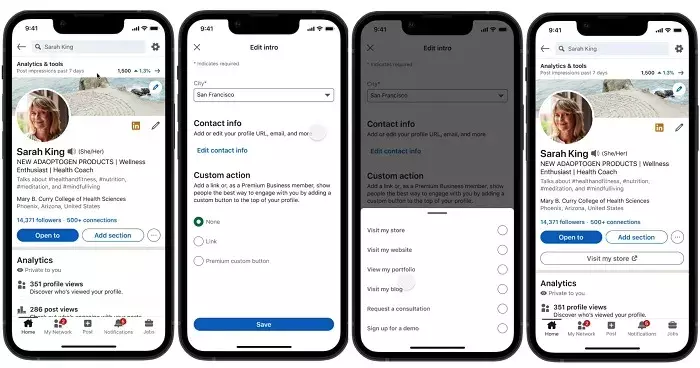In a surprising turn of events, LinkedIn has decided to eliminate the option for users to add custom links to their profiles, a feature exclusively available to Premium subscribers. This decision marks a pivotal change within the platform, which has been testing the waters of personalization and user engagement over the past few years. While the platform has prided itself on fostering professional networking and personal branding, this move raises questions about the future direction of LinkedIn’s features and how they align with user needs.
The custom Call-to-Action (CTA) buttons, introduced in 2023, allowed users to drive traffic to external sites, enhancing their professional visibility. These buttons catered to diverse needs—from promoting personal websites to directing followers to online stores. However, LinkedIn’s recent announcement indicates that they are reevaluating which features deliver substantial value to their users. The social network stated, “As part of this process, we may decide to upgrade or eliminate certain offerings so we can invest in the features that bring the most value.” This raises a critical question for users: what determines valuable functionality in an ever-evolving digital landscape?
The Premium Dichotomy: Accessibility vs. Exclusivity
Interestingly, the decision to eliminate custom links is made even more contentious by its exclusivity. With an estimated 175 million Premium subscribers and a reported 50% growth in subscriptions over the past two years, LinkedIn has carved out a significant market for premium services. However, its strategy appears to target businesses and brands rather than individual users.
The disparity between individual and business offerings is profound; while LinkedIn’s Premium Company Pages continue to thrive with enhanced visibility and utility, individual users appear to be stripped of a once-valuable tool. The company asserts this difference is based on usage trends, but it may inadvertently send the message that personal branding is less essential compared to corporate branding. In a time when personal projects and side hustles gain traction in the gig economy, this shift could stifle individual expression and nuance on a platform historically focused on fostering professional growth.
What Lies Beneath: Evaluating User Engagement
Despite the well-documented switch to contain questionable external links that may potentially harm LinkedIn’s reputation, one must consider the broader implications of restricting users from customizing their profiles. Could user engagement metrics and analytics actually indicate a demand for these features? LinkedIn fails to provide definitive reasoning for discontinuing custom links, leaving users in the dark about what this means for their profile effectiveness in an increasingly digital-first environment.
Removing the ability to add new links while maintaining existing ones might seem benign, but it inadvertently limits the potential for continuous refinement and growth on personal profiles. For many users, driving traffic from LinkedIn can be a valuable avenue for career advancement or business practices. LinkedIn’s decision translates into a disconcerting limitation: by taking away creative control, the platform risks alienating a segment of users who rely on it for professional outreach and networking.
The Future of Professional Networking
As LinkedIn pivots towards courting content creators and emphasizing company branding, one can’t help but wonder where individual users fit into this evolving narrative. Is there a vision for content creators that misses the mark by sidelining personal branding tools? With the rising influence of content creators across all social media platforms, LinkedIn must consider how to adapt its framework to be inclusive of both enterprise and individual voice.
Furthermore, as the platform looks to enhance content sharing, could removing personalization—such as custom links—lead to a dilution of engagement? Networking hinges on individuals having unique voices and stories, and the apparent trend to favor broader business functionalities over personalized features might ultimately backfire.
This bold change by LinkedIn might just signify the beginning of a new era—one that champions corporate branding at the expense of individuality. As users navigate this evolving landscape, it’s imperative for LinkedIn to champion the needs of both businesses and personal brands, ensuring it remains a relevant and valuable resource for everyone within its professional ecosystem.


Leave a Reply